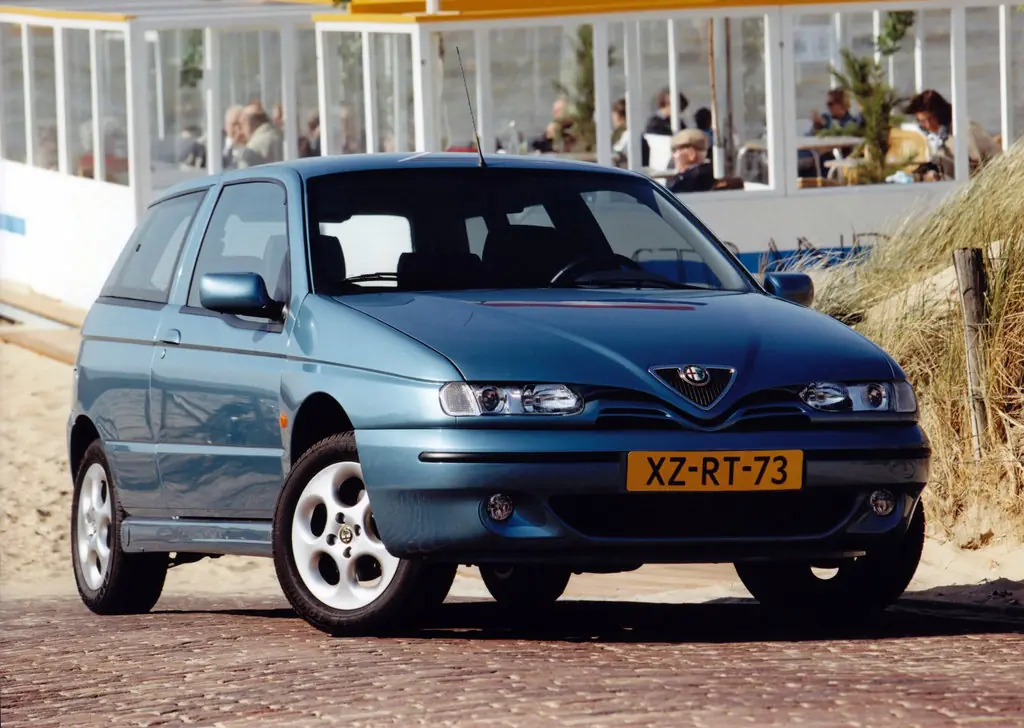The late 1990s marked a golden era for European hot hatches. While Volkswagen’s Golf GTI dominated headlines and Ford’s Focus RS grabbed attention, another player carved its own niche. The Alfa Romeo 145, particularly in its final form from 1999 to 2000, embodied Italian flair in a segment often criticized for being too sensible.
Born from Alfa’s racing heritage, this three-door hatch broke conventional design rules. Rather than following the boxy template of its German rivals, it delivered curves and character in spades. The 145 wasn’t just another compact car – it was a statement of Italian automotive philosophy.
Italian Heart with Racing Spirit
The 145’s engine lineup reads like a masterclass in Italian engineering. From the peppy 1.4-liter powerplant to the range-topping 2.0-liter Twin Spark, each engine brought its own personality to the driving experience. The sweet spot? The 1.7-liter unit, delivering 137 horsepower through a crisp manual gearbox.
Power delivery feels distinctly old-school – there’s no turbo lag because there’s no turbo. Instead, you get linear acceleration and a soundtrack that only naturally aspirated Italian engines can deliver. The Twin Spark technology wasn’t just marketing speak; it genuinely improved combustion efficiency and performance.
“My 145 2.0 Twin Spark has been with me for 15 years now. Nothing else combines daily practicality with pure driving joy quite like it. The engine note above 4000 rpm still gives me goosebumps.” – Marco Rossi, Alfa Romeo Club Italia
The front-wheel-drive setup might surprise some, but Alfa’s engineers worked magic with the chassis tuning. Turn-in is sharp, body roll is well-controlled, and the steering provides feedback that modern electric systems can only dream of.
Design Legacy
The 145’s wedge-shaped silhouette stands out even today. Its aggressive nose, distinctive side profile, and compact dimensions create a look that’s both purposeful and uniquely Italian. The 1999 facelift brought subtle refinements to the front end, enhancing the car’s presence without compromising its character.
Inside, the dashboard cants towards the driver – a racing-inspired touch that emphasizes the car’s sporting intentions. Key features that define the 145’s design philosophy include:
- trademark Alfa Romeo triangular grille;
- distinctive wedge-shaped side profile;
- wraparound rear windows;
- driver-focused cockpit layout;
- classic Italian instrument cluster design.
This combination of elements creates an interior that prioritizes driving engagement over outright luxury. Yes, some plastics feel dated by today’s standards, but the fundamentals – seating position, visibility, and control layout – remain impressive.
Daily Driver or Weekend Warrior?
Living with a 145 requires a certain mindset. The 320-liter boot handles weekly shopping runs with ease, while folding rear seats expand capacity to 1130 liters. Urban maneuverability impresses thanks to compact dimensions and responsive steering.
“People assume classic Alfas are temperamental, but my 145 has been remarkably reliable. Regular maintenance is key – find a specialist mechanic who understands these cars, and they’ll run forever.” – James Mitchell, UK Alfa Owners Club
Fuel economy varies significantly across the range. The 1.4 and 1.6 variants deliver reasonable efficiency, while the Twin Spark models demand premium fuel and deliver consumption figures reflecting their sporting character.
Parts availability remains decent through specialist suppliers and owners’ clubs. The key to ownership satisfaction lies in preventive maintenance and understanding the model’s quirks.
Performance and Handling
Raw numbers tell only part of the story, but they’re worth noting. The range-topping 2.0 Twin Spark sprints from 0-60 mph in 8.2 seconds – respectable rather than remarkable by modern standards. However, the driving experience transcends statistics.
The mechanical grip impresses most through flowing corners. The chassis communicates clearly, making it easy to judge grip levels. The manual gearbox, with its distinctive metal gate, delivers precise shifts that reward proper technique.
Essential performance highlights include:
- direct, unassisted steering at low speeds;
- well-balanced chassis dynamics;
- progressive brake feel;
- minimal understeer for a front-drive platform;
- characteristic engine note at high RPMs.
The Last of the Pure Alfas
The Alfa Romeo 145 represents more than just another 90s hatchback. It embodies a philosophy of driver engagement and character that’s increasingly rare in modern automobiles. Its quirks and imperfections don’t detract from the experience – they enhance it.
This isn’t a car that excels on paper or in comparison tests. Its appeal lies in how it makes you feel behind the wheel, the sound of its Twin Spark engine echoing off canyon walls, and the knowledge that you’re driving something truly special.
Pros and Cons
| Strengths | Weaknesses |
|---|---|
| Distinctive Italian styling sets it apart from mainstream competitors | Interior build quality falls short of German rivals |
| Engaging handling and precise steering feedback | Limited rear passenger space compared to contemporary hatchbacks |
| Strong performance from Twin Spark engines | Higher fuel consumption in performance variants |
| Practical cargo space with folding rear seats | Some electrical issues common with age |
| Growing classic status enhances value retention | Parts can be expensive and sometimes difficult to source |
| Unique character and driving experience | Rust protection less robust than some competitors |
| Strong enthusiast community support | Limited availability of good examples |
The Alfa Romeo 145 represents a fascinating intersection of practicality and passion. While it may require more attention than a contemporary Golf or Focus, it rewards owners with a driving experience that’s becoming increasingly rare. For those willing to embrace its character, it offers a unique blend of daily usability and weekend fun that few modern cars can match.

